Venue
IEEE EASe 2012 will be held at the Hotel Park.
Address: Novosadskog Sajma 35, 21000 Novi Sad, Serbia.
Web presentation: http://www.hotelparkns.com/
About Novi Sad
Novi Sad is the city in the Vojvodina, northern Serbian province, is placed on the banks of river Danube, next to the national park Fruska Gora. Twenty percent of the entire Vojvodinian population lives in Novi Sad. It is the second largest city in Serbia.
What differentiate Novi Sad from other cities in Serbia is a wide diversity of nationalities, cultures and religions. Five Orthodox churches, Jewish synagogue and Catholic cathedral in the very heart of Novi Sad symbolize the multiculturalism of this city. As the second biggest city in Serbia, Novi Sad is becoming the main cultural center in country and bears the name Serbian Athens.
 Some of the main cultural events that take place in Novi Sad every year
are "Sterijino pozorje" (theatre festival), traditional "Zmajeve decije
igre" (children's festival) and the famous "EXIT" - one of the best
music festivals in Europe. Novi Sad was also a host of the European
Basketball Championship in 2005. These and many other events largely
contribute the image of Novi Sad, Vojvodina and entire country.
Some of the main cultural events that take place in Novi Sad every year
are "Sterijino pozorje" (theatre festival), traditional "Zmajeve decije
igre" (children's festival) and the famous "EXIT" - one of the best
music festivals in Europe. Novi Sad was also a host of the European
Basketball Championship in 2005. These and many other events largely
contribute the image of Novi Sad, Vojvodina and entire country.
Novi Sad is a university city, a city of museums, galleries, libraries, theatres... It is a center of well developed journalistic and publishing industries, radio and television. Novi Sad is the seat of Matica Srpska and a city of fairs with many traditional and worldwide recognized international manifestations. It is a railway and road crossing on the main international railroad from Athens, i.e. Istanbul to Budapest.
Serbian language is in the official use in the City and so is the Cyrillic alphabet. Hungarian, Slovak and Ruthenian are also in the official use, along with their alphabets, in accordance with the Law and the Decision of the City Assembly of Novi Sad.
History of Novi Sad
According to historians, anthropologists and archeologists, area of Novi Sad was inhabited 4500 years BC. Many civilizations rode through this area; Celts, Romans, Visantins, Ostroghotes, Avars. Some of them stayed for a while and others moved forward. Millenniums and centuries after the first inhabitants came to this area, Novi Sad, its epicenter, the well known Petrovaradin was born.Thanks to Maria Teresa, Austro-Hungarian queen, Novi Sad, as well as other near by areas of Austro-Hungarian Empire, were developing fast both in cultural and historical way. On February 1, 1748, Novi Sad was proclaimed as "Free Royal City". Today, 260 years later, with its 300,000 citizens, Petrovaradin Fortress, river Danube, Fruska gora and its monasteries, Novi Sad became the most desirable destination for young Europeans. Warmth, hospitality, diversity of languages, cultures, and nationalities, transforms Novi Sad to city cosmopolite.
Have to see...
Petrovaradin Fortress
 The historic Petrovaradin Fortress is
built high on the banks of the River Danube, offering stunning views
over the city of Novi Sad. It is an ancient fortress site originally
occupied by the Romans, and re-built by the Austro Hungarian Empire to
defend against the Turks in the 17th Century. Tsar Leopold began work
on its construction, but it was finished by tsar Josef, son of Empress
Maria Teresa. It received its first crew in 1702 (a regiment of
Hungarian hussars, light cavalry and units of Serbian hayduks).
The historic Petrovaradin Fortress is
built high on the banks of the River Danube, offering stunning views
over the city of Novi Sad. It is an ancient fortress site originally
occupied by the Romans, and re-built by the Austro Hungarian Empire to
defend against the Turks in the 17th Century. Tsar Leopold began work
on its construction, but it was finished by tsar Josef, son of Empress
Maria Teresa. It received its first crew in 1702 (a regiment of
Hungarian hussars, light cavalry and units of Serbian hayduks).
During the first and the Second World War it was a military garrison
and that is what it remained until 1951, when it was turned into a
civilian object, used for cultural, artistic and tourist purposes. The
Clock Tower (Sahat Kula), a monumental object on the bastion of St. Lui
(Ludvig of Baden) dominates the whole military fortress.
Serbian National Theater
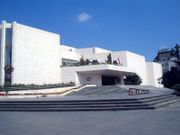 The new building of the Serbian National
Theatre, contrived by the architect Professor Dr. Viktor Jackiewitcz is
suited in the center of the town. The building was opened on March 28,
1981 (a day after the World Theatre Day). In the 120th season of its
existence, the SNT get its own building for the first time. That date
was than established for the Day of the Serbian National Theatre, when
the results of previous season are evaluated, and the best individual
and collective achievements are awarded.
The new building of the Serbian National
Theatre, contrived by the architect Professor Dr. Viktor Jackiewitcz is
suited in the center of the town. The building was opened on March 28,
1981 (a day after the World Theatre Day). In the 120th season of its
existence, the SNT get its own building for the first time. That date
was than established for the Day of the Serbian National Theatre, when
the results of previous season are evaluated, and the best individual
and collective achievements are awarded.
The building itself spreads out on more than 20,000 square meters, housing the Opera (with the Choir and Orchestra), Drama and Ballet ensembles, performing on four stages. The ballet, orchestra and choir rehearsing rooms are in its premises too. The workshops are placed in the building too, except the "Kombinat" that produces the heavy equipments and decorations.
Dunavska Street
 The most charming street in Novi Sad is
Dunavska Street. Very short, in the heart of the center, it is full of
colorful facades, many advertisements and shops. It looks like the time
has stopped there. Straight from it you get to Dunavski Park.
The most charming street in Novi Sad is
Dunavska Street. Very short, in the heart of the center, it is full of
colorful facades, many advertisements and shops. It looks like the time
has stopped there. Straight from it you get to Dunavski Park.
Catholic Cathedral
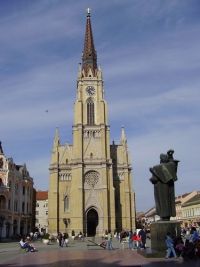 One of the symbols of Novi Sad,
neo-gothic cathedral built during the period of 1893 - 1895. is
situated in the main center square of Novi Sad, Square of Freedom.
Cathedral has beautiful tall and thin shafts. It is recognizable by its
tall clock tower, and vitrages made in Budapest. It has been built on
the place of previous church from the mid 18 century and is devoted to
St. Mary.
One of the symbols of Novi Sad,
neo-gothic cathedral built during the period of 1893 - 1895. is
situated in the main center square of Novi Sad, Square of Freedom.
Cathedral has beautiful tall and thin shafts. It is recognizable by its
tall clock tower, and vitrages made in Budapest. It has been built on
the place of previous church from the mid 18 century and is devoted to
St. Mary.
Synagogue
 The building of the new synagogue, the
fifth to be erected on the same location since the 18th century, became
a major project for the entire Jewish community of Novi Sad under the
leadership of Dr. Karl Kohn, who served as its president for nine years
(1895-1906).
The building of the new synagogue, the
fifth to be erected on the same location since the 18th century, became
a major project for the entire Jewish community of Novi Sad under the
leadership of Dr. Karl Kohn, who served as its president for nine years
(1895-1906).
The building work of the Novi Sad synagogue started in 1905 and was finished in 1909. The new synagogue was part of a larger complex of buildings that included on both sides of the synagogue two edifices decorated in a similar pattern. One building sheltered the offices of the Jewish Community and the residences specially built for the synagogue officials, while the second building served the Jewish school. Located in Jevrejska (Jewish) Street, close to the city center, the synagogue has since its inauguration been recognized as a landmark of Novi Sad.
Matica Srpska
Matica srpska (lit. "Serbian matrix", meaning "parent body of the Serbs") was founded by patriotic Serbian intellectuals and rich traders in 1826 in Pest. 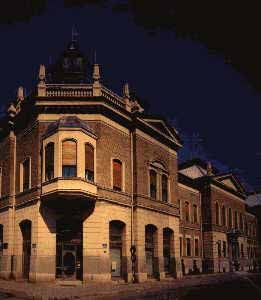 It was moved from Pest (by Jovan Forovic)
into the building of the heritage of the famous philanthropic from Novi
Sad, Mrs. Marija Trandafil in 1864. The building was built in 1912, in
pseudo classicist style according to the project by Momcilo Tapavica
(an architect, a top grade sportsman, the first Serb to participate in
the Olympic games). It includes the journal "Letopis", a rich library,
an art gallery and a publishing house. In front of the building are
sculptures of all the presidents of Matica srpska: Jovan Hadzic, Sava
Tekelija, Teodor Pavlovic, Platon Atanackovic, Tihomir Ostojic and Vasa
Stajic.
The Matica srpska Society was one of the initiators of the Novi Sad
Agreement on the Serbo-Croatian language (1954) led the action for
making the unique orthography of the language (1960). They compiled The
Vocabulary of Serbian Standard Literary Language in six volumes
(1967-1976).
It was moved from Pest (by Jovan Forovic)
into the building of the heritage of the famous philanthropic from Novi
Sad, Mrs. Marija Trandafil in 1864. The building was built in 1912, in
pseudo classicist style according to the project by Momcilo Tapavica
(an architect, a top grade sportsman, the first Serb to participate in
the Olympic games). It includes the journal "Letopis", a rich library,
an art gallery and a publishing house. In front of the building are
sculptures of all the presidents of Matica srpska: Jovan Hadzic, Sava
Tekelija, Teodor Pavlovic, Platon Atanackovic, Tihomir Ostojic and Vasa
Stajic.
The Matica srpska Society was one of the initiators of the Novi Sad
Agreement on the Serbo-Croatian language (1954) led the action for
making the unique orthography of the language (1960). They compiled The
Vocabulary of Serbian Standard Literary Language in six volumes
(1967-1976).
Matica srpska publishes the "Letopis Matice srpske" magazine, which is one of the oldest in the world, being continuously published since 1824. The Law of the Matica srpska Society (1986) regulates matters of endowment and legacy, given by the national benefactors, and how the money is spent for various cultural and educational purposes.
City Hall
It is one of four monumental buildings on Liberty Square (Trg Slobode), the main city square. It was built in 1895 and designed by a well-known architect Gyorgy Molnar. 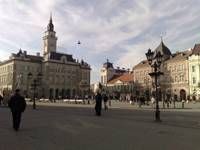 The two-floor building is in the
neo-baroque style, so the interior is richly decorated. There are 16
allegorical statues, the works of Julije Anika, along the facades. You
can see the town's coat of arms on the upper part of the facade facing
the square. The building is also decorated by a high tower with the
bell of St. Florian - Matilda.
Today, the city hall is the seat of local authorities, i.e. the
Executive Council the Assembly of Novi Sad, which is the executive body
of the City Assembly.
The two-floor building is in the
neo-baroque style, so the interior is richly decorated. There are 16
allegorical statues, the works of Julije Anika, along the facades. You
can see the town's coat of arms on the upper part of the facade facing
the square. The building is also decorated by a high tower with the
bell of St. Florian - Matilda.
Today, the city hall is the seat of local authorities, i.e. the
Executive Council the Assembly of Novi Sad, which is the executive body
of the City Assembly.
The Orthodox Cathedral Church of St. George
(The Congregational Orthodox Church - Saborna Crkva)
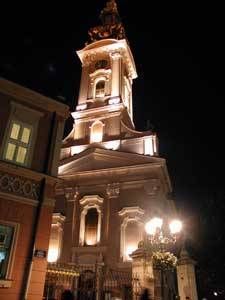 The Cathedral church of Novi Sad is
dedicated to the Holy Great Martyr George. It was built in baroque
style in 1734, during the time of the empress Maria Theresia the
patriarch Arsenije IV Jovanovic and the archpriest Visarion Pavlovic.
It burnt down during the bombing in 1849. It was rebuilt in 1860-80,
and the last reconstruction took place in 1905 thanking to archpriest
Mitrofan Sevic, after the project of Mihajl Harminc, the architect from
Budapest. New tower with new bells from Budapest was built as well.
Twenty-six icons on the iconostasis, two historical paintings above the
choir-stalls and the two great icons (on the Godmother's and the
archpriest's thrones were made in 1905 by Serbian academic painter Paja
Jovanovic, who also supervised the wall decorating. The window vitrages
were made by Imre Zseler in Budapest after the drawings of Paja
Jovanovic. The wall paintings were made by Stevan Aleksic. The church
is located in Pasiceva Street.
The Cathedral church of Novi Sad is
dedicated to the Holy Great Martyr George. It was built in baroque
style in 1734, during the time of the empress Maria Theresia the
patriarch Arsenije IV Jovanovic and the archpriest Visarion Pavlovic.
It burnt down during the bombing in 1849. It was rebuilt in 1860-80,
and the last reconstruction took place in 1905 thanking to archpriest
Mitrofan Sevic, after the project of Mihajl Harminc, the architect from
Budapest. New tower with new bells from Budapest was built as well.
Twenty-six icons on the iconostasis, two historical paintings above the
choir-stalls and the two great icons (on the Godmother's and the
archpriest's thrones were made in 1905 by Serbian academic painter Paja
Jovanovic, who also supervised the wall decorating. The window vitrages
were made by Imre Zseler in Budapest after the drawings of Paja
Jovanovic. The wall paintings were made by Stevan Aleksic. The church
is located in Pasiceva Street.
Church of the Great Martyr St. George (the Congregational Orthodox
Church)
Vigil: Saturdays and holidays at 17h
St. Liturgy: Sunday, holidays at 9h, Saturday after the morning service
The Three Saint Bishops Church
 Serbs, who settled to the periphery of
the former Petrovaradin Trench after they moved from the village Almas,
in 1718, built this church. Made of sticks it could not have lasted
long, so on the same place the new larger one was built. The archpriest
Visarion Pavlovic dedicated it in January 1733. In 1797 they built a
new one. It is the biggest Orthodox Church in Novi Sad. It has acquired
its present look at the end of the XVIII century, when it was renovated
for the last time in the early classicism style. Wood carving was done
by Aksentije Markovic, the iconostasis and wall paintings by Arsenije
Teodorovic, the famous painter, who was buried in the churchyard. In
1905 Uros Predic painted the icon of the Virgin Mary on the throne. The
church is located in Almaska Street.
Serbs, who settled to the periphery of
the former Petrovaradin Trench after they moved from the village Almas,
in 1718, built this church. Made of sticks it could not have lasted
long, so on the same place the new larger one was built. The archpriest
Visarion Pavlovic dedicated it in January 1733. In 1797 they built a
new one. It is the biggest Orthodox Church in Novi Sad. It has acquired
its present look at the end of the XVIII century, when it was renovated
for the last time in the early classicism style. Wood carving was done
by Aksentije Markovic, the iconostasis and wall paintings by Arsenije
Teodorovic, the famous painter, who was buried in the churchyard. In
1905 Uros Predic painted the icon of the Virgin Mary on the throne. The
church is located in Almaska Street.
Church of Three St. Bishops (Almaska Church), 13 Almaska street
Vigil: Saturdays and holidays at 18h
St. Liturgy: Sunday, holidays at 9h






